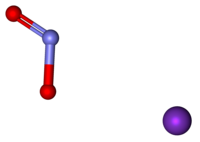Potassium nitrite
 |
|
| Identifiers | |
|---|---|
|
7758-09-0 |
|
| 3D model (Jmol) | Interactive image |
| ChemSpider |
22857 |
| ECHA InfoCard | 100.028.939 |
| EC Number | 231-832-4 |
| E number | E249 (preservatives) |
| PubChem | 516910 |
| RTECS number | TT3750000 |
| UNII |
794654G42L |
|
|
|
|
| Properties | |
| KNO2 | |
| Molar mass | 85.10379 g/mol |
| Appearance | white or slight yellow solid deliquescent |
| Density | 1.914986 g/cm3 |
| Melting point | 440.02 °C (824.04 °F; 713.17 K) (decomposes) |
| Boiling point | 537 °C (999 °F; 810 K) (explodes) |
| 281 g/100 mL (0 °C) 312 g/100 mL (25 °C) 413 g/100 mL (100 °C) |
|
| Solubility | soluble in alcohol, ammonia |
| −23.3·10−6 cm3/mol | |
| Thermochemistry | |
| 107.4 J/mol K | |
|
Std enthalpy of
formation (ΔfH |
-369.8 kJ/mol |
| Hazards | |
| Safety data sheet | External MSDS |
|
EU classification (DSD)
|
Oxidant (O) Harmful (Xn) Dangerous for the environment (N) |
| R-phrases | R8 R25 R50 |
| S-phrases | S45 S61 |
| NFPA 704 | |
| Flash point | Non-flammable |
| Lethal dose or concentration (LD, LC): | |
|
LD50 (median dose)
|
235 mg/kg |
| Related compounds | |
|
Other anions
|
Potassium nitrate |
|
Other cations
|
Sodium nitrite |
|
Except where otherwise noted, data are given for materials in their standard state (at 25 °C [77 °F], 100 kPa).
|
|
|
|
|
| Infobox references | |
Potassium nitrite (distinct from potassium nitrate) is the inorganic compound with the chemical formula KNO2. It is an ionic salt of potassium ions K+ and nitrite ions NO2−, which forms a white or slightly yellow, hygroscopic crystalline powder that is soluble in water.
It is a strong oxidizer and may accelerate the combustion of other materials. Like other nitrite salts such as sodium nitrite, potassium nitrite is toxic if swallowed, and laboratory tests suggest that it may be mutagenic or teratogenic. Gloves and safety glasses are usually used when handling potassium nitrite.
Nitrite is present at trace levels in soil, natural waters, plant and animal tissues, and fertilizer. The pure form of nitrite was first made by the prolific Swedish chemist Scheele working in the laboratory of his pharmacy in the market town of Köping. He heated potassium nitrate at red heat for half an hour and obtained what he recognized as a new “salt.” The two compounds (potassium nitrate and nitrite) were characterized by Péligot and the reaction was established as 2KNO3→2KNO2+O2.
Potassium nitrite can be obtained by the reduction of potassium nitrate. The production of potassium nitrite by absorption of nitrogen oxides in potassium hydroxide or potassium carbonate is not employed on a large scaled because of the high price of these alkalies. Furthermore, the fact that potassium nitrite is highly soluble in water makes the solid difficult to recover.
...
Wikipedia

